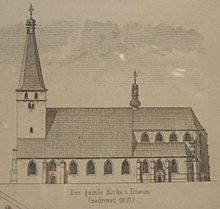Emanuel Gurlitt
Emanuel Gurlitt (born January 24, 1826 in Altona ; † July 13, 1896 in Husum ) was a German watchmaker , long-time mayor of Husum and a Low German writer.
Emanuel Gurlitt was born as the son of the gold wire puller, spice trader and essence manufacturer ("Gurlitt drops") Johann August Wilhelm Gurlitt (1774–1855) and his second wife Christine Helene (1784–1857), née. Eberstein was born in Altona, then Danish. He had seventeen siblings. His older brothers were the composer Cornelius Gurlitt and the painter Louis Gurlitt .
Gurlitt learned the trade of watchmaker. At the age of 22 he was drafted into the military during the German Revolution in 1848 . He fought as an officer in the Schleswig-Holstein War . At Kolding he suffered wounds in 1849 and in 1850 he was so badly wounded in the battle of Idstedt that his foot had to be amputated. In 1851 he was dismissed from the military as a fully disabled person without a pension. He then moved to Husum, where he opened a spice shop in 1853. He was elected councilor of the city and in 1873 its mayor.
During his 14-year tenure, among other things, he ensured that the then flourishing cattle trade in Husum finally had its own market place. Today the district building stands on its site. Among other things, he was also chairman of the Association of Advance Payment and Credit Associations in Northwest Germany. Gurlitt's importance went far beyond the narrow walls of Husum, because he also made a name for himself as a native writer and was a close friend of Theodor Storm . Because of his enormous body size, Gurlitt was considered "the thickest man in Schleswig-Holstein" at the time.
Gurlitt died on July 13, 1896 at the age of 70.
In Husum, a street was named after Emanuel Gurlitt.
It is said that Emanuel Gurlitt owned an angel by the carver Hans Brüggemann (approx. 1480–1540), who originally stood in the sacrament house in the late Gothic St. Mary's Church, which was demolished in 1807 because of dilapidation, for which the deceased artist, who worked in Husum, had another loud-playing angel and had carved a Madonna and Child. The lute-playing angel is now in the Bode Museum on Berlin's Museum Island and the Madonna and Child is owned by the Danish royal family. Gurlitt's angel is thought to be lost.
Works
- Wine sprouts . Husum 1875
- De Slacht bi de Kohstieg. En Schleswig-Holstein poetry . Leipzig 1877
- From the North Sea beach. Plattdütsche poems . Leipzig 1880
- First in the wet and then in the brilliant. En plattdütsch Lustspill in 1 Optog . Garding 1889
literature
- Carl Schulte: Lexicon of watchmaking . Emil Huebners Verlag, Bautzen 1902.
- Wilhelm Röseler: Emanuel Gurlitt . In: Lower Saxony , 1 (1896) p. 332 f.
- Heinrich Henning: The writer Emanuel Gurlitt. Wachholtz, Neumünster 1966, pp. 214-215. In: Die Heimat No. 7/1966.
Individual evidence
- ^ Gurlitt, Gustav Cornelius , Deutsche-biographie.de
- ↑ The Gurlitts - a special family . In: Husumer Nachrichten, November 8, 2013.
- ↑ Horst Appuhn: Sankt Marien in Husum (old) , abendmusiken-basel.ch, accessed on December 24, 2013
| personal data | |
|---|---|
| SURNAME | Gurlitt, Emanuel |
| BRIEF DESCRIPTION | German author |
| DATE OF BIRTH | January 24, 1826 |
| PLACE OF BIRTH | Altona |
| DATE OF DEATH | July 13, 1896 |
| Place of death | Husum |

